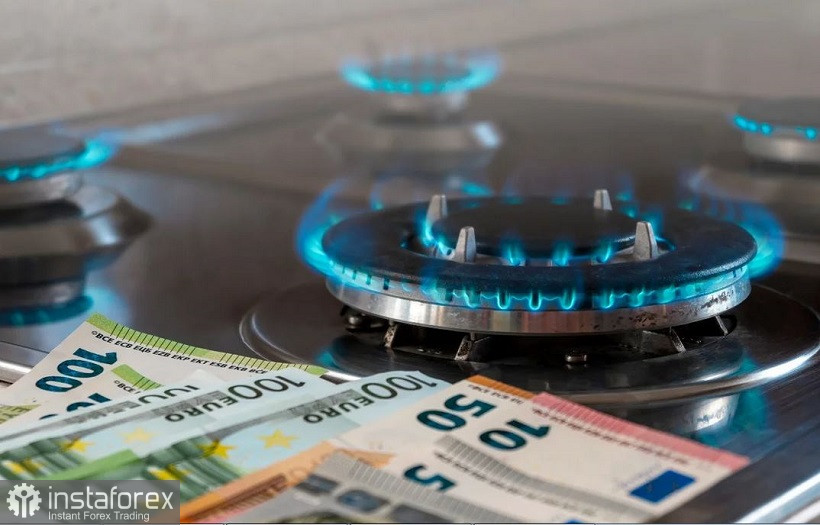The euro-dollar pair tested local lows again today, dropping into the area of the ninth figure. This time, the downward dynamics of the pair was due not only to the strengthening of the US currency, but also to the weakening of the euro. The single currency is getting cheaper throughout the market, as clearly evidenced by such cross-pairs as EUR/JPY, EUR/CHF and EUR/GBP. The energy crisis, which is growing like a snowball, exerts the strongest pressure on the euro, which is already under pressure from other fundamental factors.
Looking ahead, it should be noted that, despite the pronounced downward momentum, now both short positions and long positions of the pair look risky. And this is despite the fact that the overall mood for the pair remains bearish, given the unstable geopolitical situation. Traders are acutely reacting to foreign policy events related to the prospects for the development of the situation in Ukraine. However, today's downward momentum was not directly related to the Ukrainian events.

The euro sank sharply on the statement of the Russian president on the transfer of payment for gas in rubles. Literally immediately after these words, prices for natural gas in Europe jumped by more than 20% (in particular, the cost of the April natural gas futures at the hub in the Netherlands soared by 21% compared to Tuesday's closing level). According to Putin, it was decided "in the shortest possible time to implement a set of measures to transfer payments for natural gas supplied to so-called unfriendly countries to Russian rubles." At the same time, he added that he instructed Gazprom to make appropriate changes to the contracts.
After that, the exchange prices for gas in Europe began to rise sharply, and the euro, in turn, sank sharply throughout the market. It should be noted here that the list of unfriendly countries includes, in particular, 27 EU member states. The Russian central bank will determine the new payment procedure for gas supplies within a week. But from what has been said, it is already clear that now Europeans will have to sell euros to Russia and buy rubles for it. The estimated volume, for example, next year is at least 400 billion euros, based on current gas prices. At the same time, the European Union will not be able to abandon Russian gas in the coming years – all relevant analysts and experts agree on this opinion. Following the Russian president's statements, the price of the nearest April futures on the ICE Futures exchange soared to $1,500 per thousand cubic meters. For comparison, we can say that yesterday gas trading on the spot market ended at $ 1,077.
Oil is also becoming more expensive. The price of Brent crude oil has risen above $120 per barrel. According to many experts, commodity prices will show further growth against the backdrop of geopolitical tensions, supply chain problems, limited production growth and growing demand for travel after the pandemic.
In other words, the overall picture for the European region is, to put it mildly, not too rosy. The likely increase in inflation against the background of a decline in other macroeconomic indicators does not bode well. The term "stagflation" is increasingly voiced by experts, although the head of the ECB denied such risks during her last speech. And yet, despite European Central Bank President Christine Lagarde's optimism, the situation is not quite optimistic. Many analysts are sure that the probability of stagflation is still increasing (and not decreasing) every day, since expensive raw materials, which will continue to become more expensive, will slow down the growth of the European economy and at the same time increase the already high inflation. Such prospects put quite a lot of pressure on the euro.
On the other hand, the dollar still cannot take off due to the rapidly changing geopolitical background. Negotiations between Russia and Ukraine are continuing, and Germany and the United States have opposed sending a NATO peacekeeping contingent. These circumstances allowed EUR/USD bulls to keep the pair from further falling to the base of the 9th figure.
In general, such a contradictory fundamental picture keeps both bulls and bears of the pair in the grip. EUR/USD bears cannot gain a foothold below the 1.0960 mark (and generally stay within the ninth figure), and bulls are unable to go above the resistance level of 1.1050 (the average line of the Bollinger Bands indicator on the daily chart). Actually, the pair has been trading in this range for the last two days.
Summarizing all of the above, we can conclude that at the moment it is most practical to take a wait-and-see attitude. A riskier option is to trade in the 1.0960-1.1050 price range, counting on stable pullbacks and tides. However, in my opinion, geopolitics is not associated with any stability: a sharp increase in anti-risk sentiment (or, conversely, a sharp decrease in the degree of intensity) will allow traders to push the pair out of the above range. That's just the question in which direction. And this question, alas, is still unanswered.
 English
English 
 Русский
Русский Bahasa Indonesia
Bahasa Indonesia Bahasa Malay
Bahasa Malay ไทย
ไทย Español
Español Deutsch
Deutsch Български
Български Français
Français Tiếng Việt
Tiếng Việt 中文
中文 বাংলা
বাংলা हिन्दी
हिन्दी Čeština
Čeština Українська
Українська Română
Română

